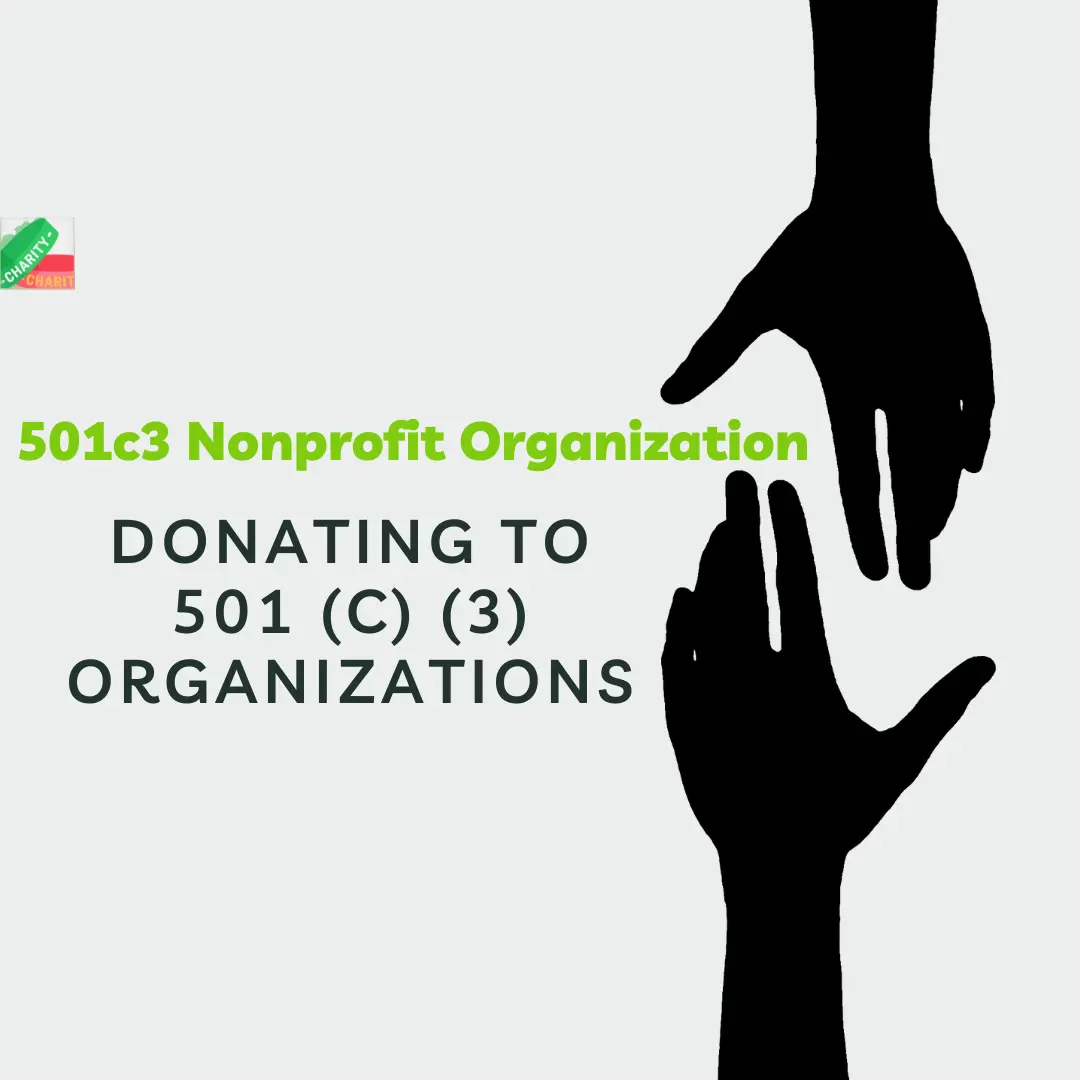501c3 Nonprofit Organization – Donating to 501 (c) (3) Organizations : Donating to 501 (c) (3) Organizations The 501 (c) (3) organization is required to be used only for exempt purposes. These include charitable, religious, educational, or artistic. These organizations can promote amateur sports, social welfare, animal protection, civil rights, and conservation or scientific research, and security. At 501 (c) (3), it cannot be political in nature or attempt to influence legislation or promote political candidates for a significant part of its activities. A 501 (c) (3) may offer educational material to legislators or represent their case before legislative bodies, but may not do so as a substantial part of their activities.
A 501 (c) (3) may, in fact, benefit from some of its activities, but the benefits should be used to further the mission of the organization. The benefits of its activities cannot be distributed to the members of the Board, staff or shareholders. The excess income is either made in reserve or used to create a donation fund for the organization. The income may also invest in new programs or activities that further the mission of the organization.
Benefits of Donating To 501 (c) (3) organizations
Donations to the (c) (3) 501 organization may be tax-deductible under IRS code section 170, except for 501 (c) (3) organizations whose mission is to conduct public safety tests. If you win, or the activities of a charity are shown to directly benefit any particular or private interest, which contributes to or influences the organization, the IRS may impose a special tax on individuals or leaders of the organization responsible for that relationship or transaction.
Organizations that lobby to file IRS Form
A (c) (3) 501 organization is limited in how much its assets can be legislative or political pressure. These activities cannot constitute a substantial part of the charity’s activities. Promoting a specific candidate for the office is totally prohibited, even if a charity can encourage participation in the electoral process and without bias towards a specific candidate. Activities for or against specific bills acts, or events are considered attempts to influence legislation. This includes connecting legislators and urging citizens to adopt, reject, or influence legislators to approve or reject the legislation. This activity is part of the substantial part calculation.
Organizations can carry out educational activities in the field of public policy issues without jeopardizing their tax-exempt status. To determine if lobbying is a substantial part of the activities, the IRS considers the time spent by staff and volunteers, the costs of communication, and the race against the organization’s overall budget. Organizations that lobby to file IRS Form 5768 every year. The IRS may impose a special tax on excessive pressure groups for a total of 25 percent of the surplus. If the organization engages in excessive pressure for 4 years, it may lose its tax-exempt status To determine if lobbying is a substantial part of the activities, the IRS considers the time spent by staff and volunteers, the costs of communication, and the race against the organization’s overall budget. Organizations that lobby to file IRS Form 5768 every year.
The IRS may impose a special tax on excessive pressure groups for a total of 25 percent of the surplus. If the organization engages in excessive pressure for 4 years, it may lose its tax-exempt status To determine if lobbying is a substantial part of the activities, the IRS considers the time spent by staff and volunteers, the costs of communication, and the race against the organization’s overall budget. Organizations that lobby to file IRS Form 5768 every year. The IRS may impose a special tax on excessive pressure groups for a total of 25 percent of the surplus. If the organization engages in excessive pressure for 4 years, it may lose its tax-exempt status The IRS may impose a special tax on excessive pressure groups for a total of 25 percent of the surplus. If the organization engages in excessive pressure for 4 years, it may lose its tax-exempt status The IRS may impose a special tax on excessive pressure groups for a total of 25 percent of the surplus. If the organization engages in excessive pressure for 4 years, it may lose its tax-exempt status
Donation for 501 (c) (3) Organizations
A foundation is a non-governmental organization that functions as a charitable institution. There are rationales for providing funding to other organizations, such as non-profit agencies, educational institutions, religious and cultural organizations, research groups, scientific and political concerns. There are three types of bases: individuals, companies, and communities. Private foundations ranging from small family foundations funded by an independent donor board operated foundations. Private foundations obtain their funds from a for-profit sponsor and are generally governed by a board of directors of the sponsoring company. Public foundations can be funded by other foundations, donations from individuals or companies, or the government. Most foundations have specific rules that regulate the organizations they support, at the time of grant application, it is important to identify each application and always keep in mind what the foundation aims to make its own funds. A good place to start searching is foundationcenter.org, which lists the bases and types of scholarships they offer.
Business Donation For 501 (c) (3) Organizations
Corporate contributions are distributed directly, not through a corporate foundation. Some companies can donate money, and some can donate materials or training. As Foundation grants, most business scholarships have specific guidelines that determine which 501 (c) 3 organizations they fund. For example, a software company might focus on funding nonprofits that promote information technology in schools, or a sporting goods company could support organizations that help the environment. Many companies choose to focus their charity spending on the areas where their businesses are located. United Way can be a helpful resource, check with your local office to determine which companies in your area have charity programs.
Government grants For 501 (c) (3) Organizations
Federal and state grants are a great source of government funding for 501 (c) 3s. There are 26 federal grantmaking agencies, such as the National and Community Service Corporation, the Department of Education, the Department of Health and Human Services, the National Endowment for the Arts, and the Environmental Protection Agency. The entire grant from such agencies can be accessed online at Grants.gov, a site that offers a database of hundreds of global funding opportunities, most of which can also be applied online. State governments also offer scholarships, your state’s funding opportunity search site.
How to Start a 501 (c) (3) Organization
The easiest way to check for starter bags at the federal level is to start the government’s Grants.gov website. It serves as a link for all government agencies. Government grants change every year, but the office most likely to have start-up money is the Office of Religious and Neighborhood Associations, which has a local mandate. It’s almost impossible for a new nonprofit to get a federal grant to start because of the strict tax controls that must be in place, but if the nonprofit has a relationship with a larger organization that can strengthen Applying and managing money, it is much more likely that applying for a federal grant will be successful.
National scholarships To start a 501 (c) (3) Organization
There are some specific national competitions for highly competitive non-profit starter scholarships. One of the best known is the green of the echo. Another is the Draper Richards Foundation. Some foundations maintain lists of helpful seed funding sources for nonprofit startups, but the easiest way to determine all available startup funds at any given time is to visit the website and do Foundation Center research by category to The financing opportunities of the Online Directory Foundation, under the original capital or “start” section.
Local sources To start a 501 (c) (3) Organization
The more local the potential funding source, the more likely it is an innovative project capable of obtaining seed funding. Most cities have a community trust (for example, the New York Community Trust), which is more affordable compared to national foundations. Some local government agencies provide funding for the implementation of an innovative concept test and community engagement. However, it is a fact that donations from individual donors make up the group’s greatest contribution to non-profit organizations. The start money will be more accessible to a cardholder.
How to Get a 501C number
Here we are sharing a step by step guide Which will be helping you to get a 501c Number easily
- Determine the full legal name of the organization. Often times, an organization will be known for a shortened or alternate version of its full legal name, which is listed in the forms of communication that can be found.
- Perform an Internet search for the organization. If the organization is a 501 (c) (3) organization, it will be more usually to list this fact prominently on their websites. If your organization has a different name, however, you may need to look at the captions to determine the purpose of the organization.
- Review IRS Publication 557. On the first pages of this document, the various (c) 501 organizations are described at the end. This step will help you identify what type of tax-exempt organization is maintained.
- Search in a document database. The Foundation Center and the IRS maintain electronic files of declaration forms submitted by almost all 501 (c) organizations. Use the full name of the organization to search for these databases.
Identifying the relevant information. Disclosure forms are twisted and full of information that you may or may not be helpful. The important numbers to consider are revealed to the organization’s purpose, which will be marked on the form and clarified by the additional documents, the employer identification number, which gives a unique identity to each tax-exempt organization in the country.
Difference between 501 (c) (3) and 501 (c) (4) non-profit organizations
Nonprofit organizations, or 501 (c) organizations, have several advantages over for-profit companies. The IRS generally does not tax the income of 501 (c) corporations. Government grants and tax-deductible contributions are often obtained by certain organizations. The Internal Revenue Code, Title 25, Section 501 (c) defines several classes of tax-exempt organizations, including 501 (c) (3) and 501 (c) (4) nonprofits. Despite the similarities between the two types of nonprofit organizations, they have different requirements and restrictions on their activities.
The objectives or missions of nonprofit organizations must match those specified in Section 501. 501 (c) (3) organizations are exclusively operated for charitable purposes, including helping the poor. Other purposes include implementing educational initiatives, promoting science, and promoting religious beliefs. Individuals and shareholders cannot benefit from net profit distributions. The American Red Cross and The Salvation Army are both (c) (3) non-profit organizations. In order to qualify as a 501 (c) (4) nonprofit organization, the organization must promote social welfare exclusively. Local employee associations may also qualify as non-profit organizations (c) (4). To fulfill your charitable, educational, or recreational objectives, your net proceeds must go exclusively to your chosen charity. In addition to AARP, the National Rifle Association is a nonprofit (c) (4) organization.
FAQ’s
What is the difference between 501c3 and a non profit organization?
There is no difference between 501c3 and a nonprofit organization. The term is use interchangeably as per their functionality. 501c3 are the nonprofit originations that are recognized by IRS and Offer Tax redemption where as non profit organizations are the entity that work with welfare or without profit purpose
What do you mean by 503(c)(3 organization?
You should understand that the 501 (c)(3) organization is a United States Corporation, unincorporated association, trust or any different type of organization that is exempted from federal income tax under section 501 (c)(3) of Title 26 of the United States. There are around 29 types of 501(c) non-profit organizations in the United States.
How many types of non profit organizations are there?
There are mainly four types of non profit organizations. You can surely find all the different types of non profit organizations through the IRS 557. The four types of nonprofit organizations include trade organizations, social advocacy groups, foundation and public charities. These organizations are quite common.
How many types of Charitable organizations are there?
You will be able to find three types of charitable organizations that include private operating foundations, private foundations and public charities. These organizations are eligible under the three main categories.
Is it possible to earn money using a non-profit organization?
Always remember that the aim of the non-profit organization is not to earn any profits. But there are some ways that are followed by non profit organizations to earn money or profits.
What is meant by 501(c) (4)?
The organizations whose aim is not to earn profit and are only constructed for promoting social welfare. Such organizations can exempt tax as stated by the Internal Revenue Code (IRC) section 501(c)(4).
How does the 501c3 differ from the 501 C )( 5)?
You should clearly understand that the 501(c)(5) organizations are exempt from all types of federal income tax but not from those funds that are used for lobbying and other political activities. On the other hand any contribution from the members or supporters to the 501(c)(5) organization are not tax exempted.
How does the 501c3 differ from the 501( c )( 6)?
The main difference between these two types of organization is their aim. The 501c3 organization aims to serve the public in general. On the other hand the 501(c )( 6) organization mainly aims to serve their members. The 501( c )( 6) organizations are stated as non-charitable and nonprofit membership organizations.
How does the 501c3 differ from the 501 C )( 7)?
The 501(c)(3) organization needs to spend their earnings or profit for a charitable cause as it will help them to exempt the tax. On the other hand the 501 C )( 7) social club’s purpose is not charitable but it is important that it should be non profitable and recreational. Also remember that 501 C )( 7) is limited by membership.
How does the 501c3 differ from the 501 C )( 19?
It is seen that most of the states allow 501c3 to be exempt from sales tax on property taxes and also on purchases. Whereas the 501(c)(19) veteran’s organizations are also able to allow their donors to deduct the federal income tax returns through charitable contributions.
Are the donations that are made to the 501 c 3 organizations tax-deductible?
If you have donated funds to 501(c)3 you will be able to claim deduction on your federal taxes. It is important for you to file a Schedule A with your tax form to deduct your donations. However, you also need proper documentation to claim cash donations or vehicles.
What will happen when a non-profit organization earns profits?
There are tax exempt non profit organizations that are making money through various activities and are often used to cover all the expenses. But without income it is not possible for an organization to survive in the long run. When the non-profit organization’s activities are related to the non-profit’s purpose, then any profit that is made from there is not taxable as income.




